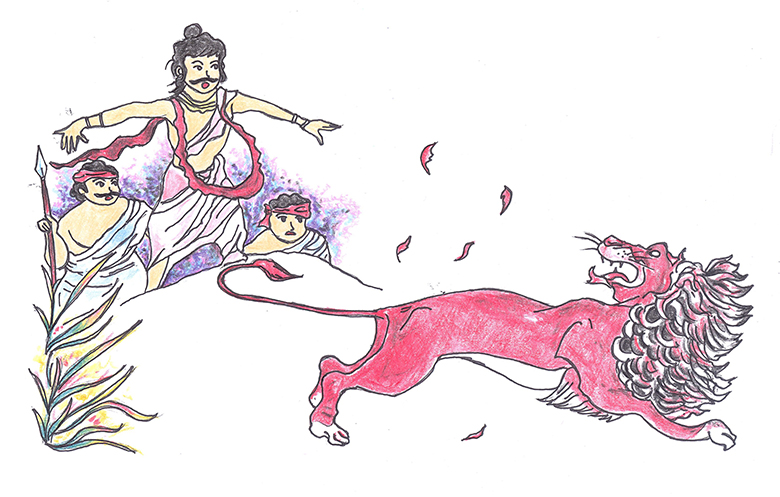Early this year, MOE announced that the secondary school History syllabus would be revamped to include more coverage on 14th century Singapore, which is the time before Raffles.
For the rest of you old(er) folks, here’s a quick primer on pre-colonial Temasek, whose rise and fall is the stuff of Hollywood blockbusters.
1. Lion (not) City

Malay legend tells of a prince (Sang Nila Utama) who upon landing on Temasek, thought he saw a lion and, in a sudden fit of inspiration, decided to name it Singapura – Lion City. Except that lions do not exist on the island naturally. It is speculated that he saw a tiger, or an Asian Golden Cat instead. Well, good for us. Kucing-pura doesn’t quite have the same ring does it?
2. Para – who?
 Parameswara, paragon of immaculate facial grooming
Parameswara, paragon of immaculate facial grooming
Temasek was ruled by a grand total of 5 kings. According to some scholars, the last king was known as Parameswara or Iskandar Shah. Taking accounts from different sources, you might find that Parameswara was a Javanese subject who fled from his country to Temasek, murdered the local ruler, took over the throne and was later driven out by his own ex-boss. Having lost his (stolen) empire, he ran to the north and went on to found Melaka. He would be the friend you would love to hate.
3. A Forbidden Hill
Fort Canning, as it is known today, used to be called Bukit Larangan – Forbidden Hill – the site of an ancient royal palace, and subsequently, the supposed burial sites of Singapura kings. Today, you won’t find much trace of a palace. What you will find, though, are early Malay and Chinese artefacts, purportedly belonging to royalty, excavated from the slopes. You will also find what is believed to be the resting place of Iskandar Shah – a shrine (called a keramat) still stands there today in honour of him.
4. Ahoy lah

Another group of indigenous folks settled near the shore at a location called Dragon Tooth Straits (present day Labrador Park to Keppel bay). Armed with poisoned darts, the Dragon Tooth Straits folks sent hundreds of boats to attack Chinese trading ships on the way home to China. Not only did they loot the ships clean, everybody on board the doomed vessels were slaughtered. Think of it as the local version of 300, but with blowguns and more clothes.
5. Asian Tiger
 Chinese ceramic compass fragments – evidence of Chinese trade
Chinese ceramic compass fragments – evidence of Chinese trade
Aside from being a pirate bay, Temasek was quite the manufacturing and trade hub. 14th century Chinese trader Wang Dayuan wrote that the city engaged in rice wine distillation. Local traders offered scented woods and tin ore in exchange for gold, silk, pottery and metal containers. Excavations have also found remains of gold, copper, bronze and glass workshops. Even the Mongol empire sent ambassadors here to trade for tame elephants!
6. The First Chinatown
In his book – unabashedly titled Barbarians of the Isles - Wang Dayuan described an overseas group of Chinese who lived peacefully alongside the Malay locals and assimilated into their everyday activities. This description seems to be the first written account of a settled overseas Chinese community in Southeast Asia, providing conclusive proof that the Chinese are indeed everywhere.
7. Pioneers of NS
 The wall, called the Old Lines of Singapore on a map dating 1825.
The wall, called the Old Lines of Singapore on a map dating 1825.
The Temasek empire had strong defences. Firstly, it had a military strong enough to successfully fend off repeated attacks from Siam and Java. Second, the city built a strong wall which surrounded the northern side of the Forbidden Hill and ran along what is present-day Stamford Road. According to records, the wall was about 5 metres broad at the base, about 2.5 metres high, and made of bricks. Impressive considering that defensive structures during that period were usually made of bamboo or logs.
8. Hell Hath No Fury Like A Woman the Father of a Woman Scorned
The fall of Temasek was a cautionary tale in itself. Malay legend tells us that Iskandar Shah accused his concubine of adultery and had her stripped in public. Her father, an official in the court, was mad. In order to exact revenge, he conspired with the Javanese and opened the gates of the impregnable fortress during battle to let them in, leading to a literal bloodbath. Iskandar Shah fled with his entourage and the empire fell into ruin. Take-home lesson? Never ever offend your father-in-law. He will burn your house down.
More info on 14th / 15th century Singapura and excavated artefacts can be found at these places:
- National Museum – Singapore History Gallery
- Asian Civilisations Museum – Singapore River Gallery
- Fort Canning Park – Archaeological Dig
- NTU Chinese Heritage Centre, 3rd floor – From Danmaxi to Xinjiapo: Ceramics and the Chinese in Singapore
- NUS Museum – Sherd Library
- World of Temasek – Travel back in time in the comfort of your own armchair!
Top photo from Asian Folk Tales
If you like what you read, follow us on Facebook, Instagram, Twitter and Telegram to get the latest updates.


